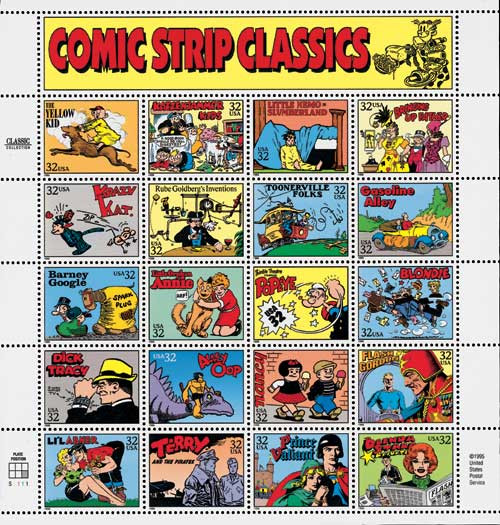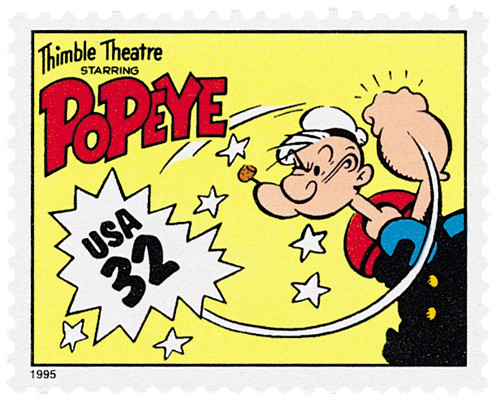
# 3000m - 1995 32c Comic Strip Classics: Dick Tracy
U.S. #3000m
1995 32¢ Dick Tracy
Comic Strip Classics
- Third sheet in the Classic Collection Series
Stamp Category: Commemorative
Set: Comic Strip Classics
Value: 32¢, rate for first-class mail
First Day of Issue: October 1, 1995
First Day Cities: Boca Raton, Florida
Quantity Issued: 300,000,000
Printed by: Stamp Venturers
Printing Method: Photogravure
Format: Panes of 20 in sheets of 120
Perforations: 10.1 x 10.2
Why the stamps were issued: The Comic Strip Classics sheet was the third issue in the Classic Collection Series. There was push to create a stamp to honor American comics as early as the 1960’s, but didn’t get real consideration until 1993. With the 100th anniversary of the comic The Yellow Kid, a comic committee, and an 83-page proposal the USPS finally agreed.
About the stamp designs: Even though only one stamp was approved, Terrence McCaffrey, head of stamp design, thought there was no way to honor American Comics with one single stamp. Therefore, he had a list of all proposed stamps and had Carl Herrman, art director, mock up a sheet of 20 stamps. McCaffrey wanted all the stamps to be taken from original panels by their respected artist. Herrmann worked on going through thousands of panels to find comics of the 20 chosen that showed the central theme of the comic in one panel with clean lines. Then with the help of American Color, that colorizes most of the comics in American newspapers, he was able to colorize them with accurate color choices, even those that were outdated.
Dick Tracy (#3000m) – There were no other option even considered except showing Dick Tracy with his “two-way wrist TV.” This was the last image that was taken pretty much exactly from the proposal.
About the printing process: In order to include the text on the back of each stamp, it had to be printed under the gum, so that it would still be visible if a stamp was soaked off an envelope. Because people would need to lick the stamps, the ink had to be approved by the Food and Drug Administration as non-toxic. The printer also used an extra-fine 300-line screen, which resulted in some of the highest-quality gravure stamp printings in recent years.
History the stamps represent:
Dick Tracy
Chester Gould, who has been referred to as the “Expressionist of the Comics,” began his career as a sports cartoonist in Chicago. It wasn’t until the creation of his plainclothes detective however, that his talent for strip narrative and realistic characterization was discovered. Dick Tracy made its debut in newspapers in 1931. Although not the first detective strip created, it was so popular that it became the criterion against which all other crime strips were measured. The strip owed much of its popularity to the fact that nearly everyone could identify with the simplicity of Dick Tracy’s world – a world of good versus evil and right versus wrong.
U.S. #3000m
1995 32¢ Dick Tracy
Comic Strip Classics
- Third sheet in the Classic Collection Series
Stamp Category: Commemorative
Set: Comic Strip Classics
Value: 32¢, rate for first-class mail
First Day of Issue: October 1, 1995
First Day Cities: Boca Raton, Florida
Quantity Issued: 300,000,000
Printed by: Stamp Venturers
Printing Method: Photogravure
Format: Panes of 20 in sheets of 120
Perforations: 10.1 x 10.2
Why the stamps were issued: The Comic Strip Classics sheet was the third issue in the Classic Collection Series. There was push to create a stamp to honor American comics as early as the 1960’s, but didn’t get real consideration until 1993. With the 100th anniversary of the comic The Yellow Kid, a comic committee, and an 83-page proposal the USPS finally agreed.
About the stamp designs: Even though only one stamp was approved, Terrence McCaffrey, head of stamp design, thought there was no way to honor American Comics with one single stamp. Therefore, he had a list of all proposed stamps and had Carl Herrman, art director, mock up a sheet of 20 stamps. McCaffrey wanted all the stamps to be taken from original panels by their respected artist. Herrmann worked on going through thousands of panels to find comics of the 20 chosen that showed the central theme of the comic in one panel with clean lines. Then with the help of American Color, that colorizes most of the comics in American newspapers, he was able to colorize them with accurate color choices, even those that were outdated.
Dick Tracy (#3000m) – There were no other option even considered except showing Dick Tracy with his “two-way wrist TV.” This was the last image that was taken pretty much exactly from the proposal.
About the printing process: In order to include the text on the back of each stamp, it had to be printed under the gum, so that it would still be visible if a stamp was soaked off an envelope. Because people would need to lick the stamps, the ink had to be approved by the Food and Drug Administration as non-toxic. The printer also used an extra-fine 300-line screen, which resulted in some of the highest-quality gravure stamp printings in recent years.
History the stamps represent:
Dick Tracy
Chester Gould, who has been referred to as the “Expressionist of the Comics,” began his career as a sports cartoonist in Chicago. It wasn’t until the creation of his plainclothes detective however, that his talent for strip narrative and realistic characterization was discovered. Dick Tracy made its debut in newspapers in 1931. Although not the first detective strip created, it was so popular that it became the criterion against which all other crime strips were measured. The strip owed much of its popularity to the fact that nearly everyone could identify with the simplicity of Dick Tracy’s world – a world of good versus evil and right versus wrong.













